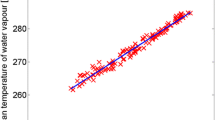Abstract
The EUMETNET EIG GNSS Water Vapour Programme (E-GVAP) is responsible for the coordination of near real time GPS Zenith Total Delay (ZTD) production in Europe and for aiding the development of ZTD assimilation into Numerical Weather Prediction (NWP) models. Since 2000, the Geodetic Observatory Pecný (GOP) has been routinely estimating regional ZTDs in near real time. In 2010, GOP developed a modified processing system in order to provide the first optimal and robust ZTD solution with a global scope and hourly upgrade, fulfilling the requirements for assimilation into operational NWP models. Since July 2010, the GOP global tropospheric product has consisted of about 90 sites and has contributed routinely in a testing mode into the E-GVAP database. Global near real time ZTDs generated over ten months have been evaluated with respect to IGS and EUREF routine post-processed ZTD products, ZTDs integrated from radiosonde profiles, and ZTDs calculated from the Met Office global NWP model. Comparison with the GNSS post-processed solutions gives standard deviations of 3–6 mm in ZTD and biases of 1–2 mm, which is comparable to GOP regional near real time solution, however, for some isolated or low data quality stations up to 20 % quality decrease can be found. Comparison with NWP shows a latitudinal trend in the standard deviation with values as low as 4 mm at high latitudes, increasing to almost 20 mm in the tropics, and a lack of variability in the model background ZTD in the tropics. The evaluation with global radiosondes gives ZTD standard deviation of 5–16 mm, which is comparable with previous studies in European scope. Since the 10-month comparison gave satisfactory results, GOP was asked by UK Met Office to disseminate the global product to the end users via the Global Telecommunications System. Since 10 October 2011, the GOP global ZTD product configuration has been extended to about 164 global stations and still processed within 10 min. However, in GOP routine contribution to E-GVAP, about 124 stations are available in general due to hourly data latency above 30 min or data gaps.












Similar content being viewed by others
References
Bennitt G, Jupp A (2012) Operational assimilation of GPS Zenith total delay observations into the UK Met Office numerical weather prediction models. Mon Weather Rev 140(8):2706–2719. doi:10.1175/MWR-D-11-00156.1
Bevis M, Businger S, Herring TA, Rocken C, Anthes R, Ware R (1992) GPS meteorology: remote sensing of atmospheric water vapor using the global positioning system. J Geophys Res 97(D14):15787–15801
Bevis M, Chiswell S, Hering TA, Anthes R, Rocken C, Ware RH (1994) GPS meteorology: mapping zenith wet delays onto precipitable water. J Appl Meteorol 33:379–386
Byun SH, Bar-Sever YE (2009) A new type of troposphere zenith path delay product of the international GNSS service. J Geodesy 83:367–373. doi:10.1007/s00190-008-0288-8
Dach R, Hugentobler U, Fridez P, Meindl M (eds) (2007) Bernese GPS software version 5.0, User Manual, Astronomical Institute, University of Bern, Bern, Switzerland
Dousa J (2001a) Towards an operational near-real time precipitable water vapor estimation. Phys Chem Earth Part A 26(3):189–194
Dousa J (2001b) The impact of ultra-rapid orbits on precipitable water vapor estimation using ground GPS network. Phys Chem Earth Part A 26(6–8):393–398
Dousa J (2004) Precise orbits for ground-based GPS meteorology: processing strategy and quality assessment of the orbits determined at geodetic observatory pecný. J Meteorol Soc Jpn 82:371–380
Dousa J (2012) Development of the GLONASS ultra-rapid orbit determination at geodetic observatory pecný, In: Kenyon S, Pacino MC, Marti U (eds) Geodesy for planet earth, proceedings of the IAG symposium, buenos aires, 31 August–4 September, vol 136. International Association of Geodesy Symposia, pp 1029–1035
Dow JM, Neilan RE, Gendt G (2005) The International GPS Service (IGS): celebrating 10th anniversary and looking to the next decade. Adv Space Res 36(3):320–326
Haase J, Ge M, Vedel H, Calais E (2003) Accuracy and variability of GPS tropospheric delay measurements of water vapor in the western mediterranean. J Appl Meteorol 42:1547–1568
Pacione R, Vespe F (2008) Comparative studies for the assessment of the quality of near-real-time GPS-derived atmospheric parameters. J Atmos Ocean Technol 25:701–714
Pacione R, Pace B, Vedel H, de Haan S, Lanotte R, Vespe F (2011) Combination methods of tropospheric time series. Adv Space Res 47:323–335
Poli P, Moll P, Rabier F, Desroziers G, Chapnik B, Berre L, Healy S, Andersson E, El Guelai FZ (2007) Forecast impact studies of zenith total delay data from European near real-time GPS stations in Meteo France 4DVAR. J Geophys Rev 112:D06114. doi:10.1029/2006JD007430
Rebischung P, Griffiths J, Ray J, Schmid R, Collilieux X, Garayt (2011) IGS08: the IGS realization of ITRF2008. GPS Solut pp 1–12. doi:10.1007/s10291-011-0248-2
Soehne W, Weber G (2002) EUREF troposphere combination at BKG—first results and improvements, extended abstracts of the COST-716 Workshop, January 28–29, Potsdam, Germany
Vedel H, Mogensen KS, Huang XY (2001) Calculation of zenith delays from meteorological data, comparison of NWP model, radiosonde and GPS delays. Phys Chem Earth Part A 26(6–8):497–502
Wang J, Zhang L (2008) Systematic errors in global radiosonde precipitable water data from comparison with ground-based GPS measurements. J Clim 21(10):2218–2238. doi:10.1175/2007JCLI1944.1
Zumberge JF, Heflin MB, Jefferson DC, Watkins MM, Webb FH (1997) Precise point positioning for the efficient and robust analysis of GPS data from large networks. J Geophys Res 102(B3):5005–5017
Acknowledgments
We thank IGS and EUREF and all its contributors for global data and products used in GOP analysis. The British Atmospheric Data Centre and Met Office UK are acknowledged for providing the global radiosonde data for the ZTD evaluation. The work was partly supported by the Czech Science Foundation (P209/12/2207) and by the European Regional Development Fund (ERDF), project “NTIS—New Technologies for Information Society”, European Centre of Excellence, CZ.1.05/1.1.00/02.0090.
Author information
Authors and Affiliations
Corresponding author
Rights and permissions
About this article
Cite this article
Dousa, J., Bennitt, G.V. Estimation and evaluation of hourly updated global GPS Zenith Total Delays over ten months. GPS Solut 17, 453–464 (2013). https://doi.org/10.1007/s10291-012-0291-7
Received:
Accepted:
Published:
Issue Date:
DOI: https://doi.org/10.1007/s10291-012-0291-7




